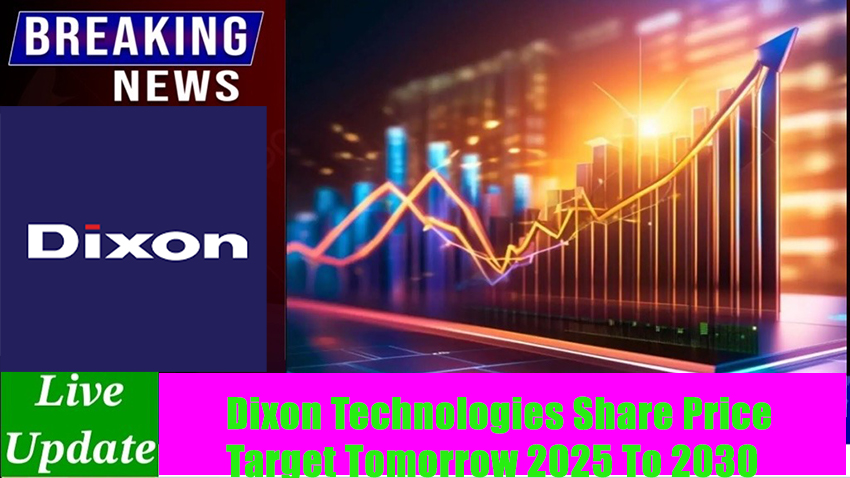Dixon Technologies Share Price Target Dixon Technologies (India) Ltd is a prominent electronics manufacturing company based in India, specializing in design and manufacturing solutions across various sectors, including consumer electronics, home appliances, lighting, mobile phones, and more. Established as a key player in the industry, Dixon Technologies manufactures products for leading brands, offering services such as assembly, testing, and product design.
Dixon Technologies Share Price Target Tomorrow 2025, 2026, 2027, 2028, 2029 To 2030
Dixon Technologies Share Price Target Tomorrow 2025 ₹19,150, 2026 ₹25,000, 2027 ₹35,500, 2028 ₹40,900, 2029 ₹45,700 To 2030 ₹50,400. Dixon Technologies is an Indian multinational electronics manufacturing services company, based in Noida. It is a contract manufacturer of televisions, washing machines, smartphones, LED bulbs, battens, downlighters and CCTV security systems for companies such as Samsung, Xiaomi, Panasonic and Philips.
- Founded: 1993
- Founder: Sunil Vachani
- Headquarters: India
- Number of employees: 1,693 (2024)
- Revenue: 12,192 crores INR (FY23, US$1.5 billion)
- Subsidiaries: Padget Electronics Private Limited ·
Dixon Technologies Share Price Target 2025-2030
| Year | Share Price Target |
| 2025 | ₹19,150 |
| 2026 | ₹25,000 |
| 2027 | ₹35,500 |
| 2028 | ₹40,900 |
| 2029 | ₹45,700 |
| 2030 | ₹50,400 |
| Category | Stock Market |
Market Overview of Dixon Technologies (India) Ltd
| Metric | Value |
| Open Price | ₹16,400.00 |
| High Price | ₹17,028.00 |
| Low Price | ₹16,104.25 |
| Previous Close | ₹16,274.90 |
| Volume | 532,385 |
| Value (Lacs) | ₹89,880.43 |
| VWAP | ₹16,618.76 |
| UC Limit | ₹17,902.35 |
| LC Limit | ₹14,647.45 |
| P/E Ratio | ₹120.80 |
| Dividend Yield | 0.034% |
| 52-Week High | ₹19,148.90 |
| 52-Week Low | ₹5,782.85 |
| Market Capitalization | ₹88,530 Cr |
| Face Value | ₹2 |
Factors Influencing Dixon Technologies’ Share Price Target for 2025: ₹19,150
- Supply Chain Disruptions: Dixon Technologies heavily relies on global supply chains for raw materials and components. Disruptions caused by geopolitical tensions, trade restrictions, or shortages (such as in semiconductors) could affect production timelines, increase costs, and delay product delivery.
- Intense Market Competition: The electronics manufacturing services (EMS) industry is highly competitive, with both local and international players striving for market share. Increased competition from low-cost manufacturers or larger companies with greater resources could squeeze Dixon’s margins and hinder its growth in 2025.
- Fluctuations in Raw Material Prices: The cost of key raw materials, such as metals and electronic components. Is subject to price volatility. Any significant increase in these costs could impact profit margins. Especially if Dixon Technologies is unable to pass these increases onto customers, potentially affecting its financial performance and share price.
Dixon Technologies Share Price Target 2026
| Year | Share Price Target (INR) |
| 2026 | ₹25,000 |
Dixon Technologies Share Price Target 2027
| Year | Share Price Target (INR) |
| 2027 | ₹35,500 |
Dixon Technologies Share Price Target 2028
| Year | Share Price Target (INR) |
| 2028 | ₹40,900 |
Dixon Technologies Share Price Target 2029
| Year | Share Price Target (INR) |
| 2029 | ₹45,700 |
Factors Influencing Dixon Technologies’ Share Price Target for 2030: ₹50,400
- Technological Obsolescence: As Dixon operates in a rapidly changing tech sector. The company must stay at the forefront of technological advancements. Failing to adopt new technologies, such as automation or AI. could undermine its competitiveness and reduce demand for its products, affecting its stock price by 2030.
- Regulatory and Compliance Risks: As Dixon expands both domestically and internationally. It may face stricter regulations across different markets. Changes in environmental, labor. Or trade policies could increase operational costs and create challenges in managing international operations, which may negatively affect profitability and stock price by 2030.
- Economic Downturns and Consumer Demand Fluctuations: The electronics market is sensitive to economic cycles, and prolonged economic slowdowns or downturns could reduce consumer spending on electronics. Directly affecting Dixon Technologies’ revenue growth and share price by 2030.
Shareholding Pattern of Dixon Technologies (India) Ltd
| Category | Percentage |
| Promoters | 32.89% |
| Foreign Institutional Investors (FII) | 22.69% |
| Domestic Institutional Investors (DII) | 23.14% |
| Public | 21.28% |
Dixon Technologies (India) Ltd Financials
| Metric | Value | Y/Y Change |
| Revenue | ₹176.91 Billion | +45.10% |
| Operating Expense | ₹11.02 Billion | +45.01% |
| Net Income | ₹3.68 Billion | +43.92% |
| Net Profit Margin | 2.08% | -0.95% |
| Earnings Per Share | ₹62.46 | +46.55% |
| EBITDA | ₹6.64 Billion | +34.33% |
| Effective Tax Rate | 24.08% | — |
What does dixon technology do?
Dixon Technologies (India) Limited is an electronics manufacturing services (EMS) company that manufactures and repairs consumer electronics. They also offer reverse logistics services.
What is the debt of Dixon Technologies?
DIXON’s net debt to equity ratio (4.7%) is considered satisfactory. Reducing Debt: DIXON’s debt to equity ratio has reduced from 28.7% to 14.1% over the past 5 years.
What is the salary of Dixon CEO?
Dixon Technologies (India)’s CEO is Atul Lall, appointed in Jul 2015, has a tenure of 9.5 years. total yearly compensation is ₹86.04M, comprised of 37.9% salary and 62.1% bonuses, including company stock and options. directly owns 3.38% of the company’s shares, worth ₹34.33B.
